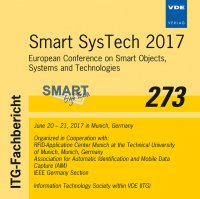SHF RFID System for Automatic Process Optimization with Intelligent Tools
Conference: Smart SysTech 2017 - European Conference on Smart Objects, Systems and Technologies
06/20/2017 - 06/21/2017 at Munich, Germany
Proceedings: Smart SysTech 2017
Pages: 8Language: englishTyp: PDF
Personal VDE Members are entitled to a 10% discount on this title
Authors:
Kuhn, Peter; Meyer, Frederic (Fraunhofer Institute for Microelectronics Circuits and Systems, 47057 Duisburg, Germany)
Haddadian, Sanaz; Scheytt, J. Christoph (Heinz Nixdorf Institute, University of Paderborn, 33102 Paderborn, Germany)
Hoffmann, Marc (D4us GmbH, 47057 Duisburg, Germany)
Grabmaier, Anton (Fraunhofer Institute for Microelectronics Circuits and Systems, 47057 Duisburg, Germany & University of Duisburg-Essen, 47057 Duisburg, Germany)
Kaiser, Thomas (D4us GmbH, 47057 Duisburg, Germany University of Duisburg-Essen, 47057 Duisburg, Germany)
Abstract:
In this paper we present theoretical, simulated and measured data for a reader to tag communication RFID system at 5.8 GHz. First a theoretical link budget analysis for a reader to tag architecture is shown for a wireless industrial application at 1m distance. This includes a power budget of the passively powered transponder. The received power level of the backscattered data for the theoretical link budget is -52:5 dBm. For the first setup slot antennas are developed and measured in the anechoic chamber. The measured gain is 4.0 dB. The power of the backscatter data in setup 1 is -74:8 dBm. This corresponds to the theoretical link budget since, all losses such as cable or lower antenna gain are taken into account. Setup 2 is upgraded on the reader side with horn antennas. At 5.8 GHz, the gain reaches the value of 10.8 dB. The second setup shows improvement in the receiving backscattered power to a value of -62:4 dBm. Furthermore, as a solution to detect those transponders not presented in the main slope of the antenna, a steerable beam is introduced by means of a Rotman lens. On the topic of the passive transponder, different harvesting topologies at 5.8 GHz are investigated, and the efficiency simulation of the harvesting circuitry has been performed. The simulated efficiency of the implemented technique is 68 %.


